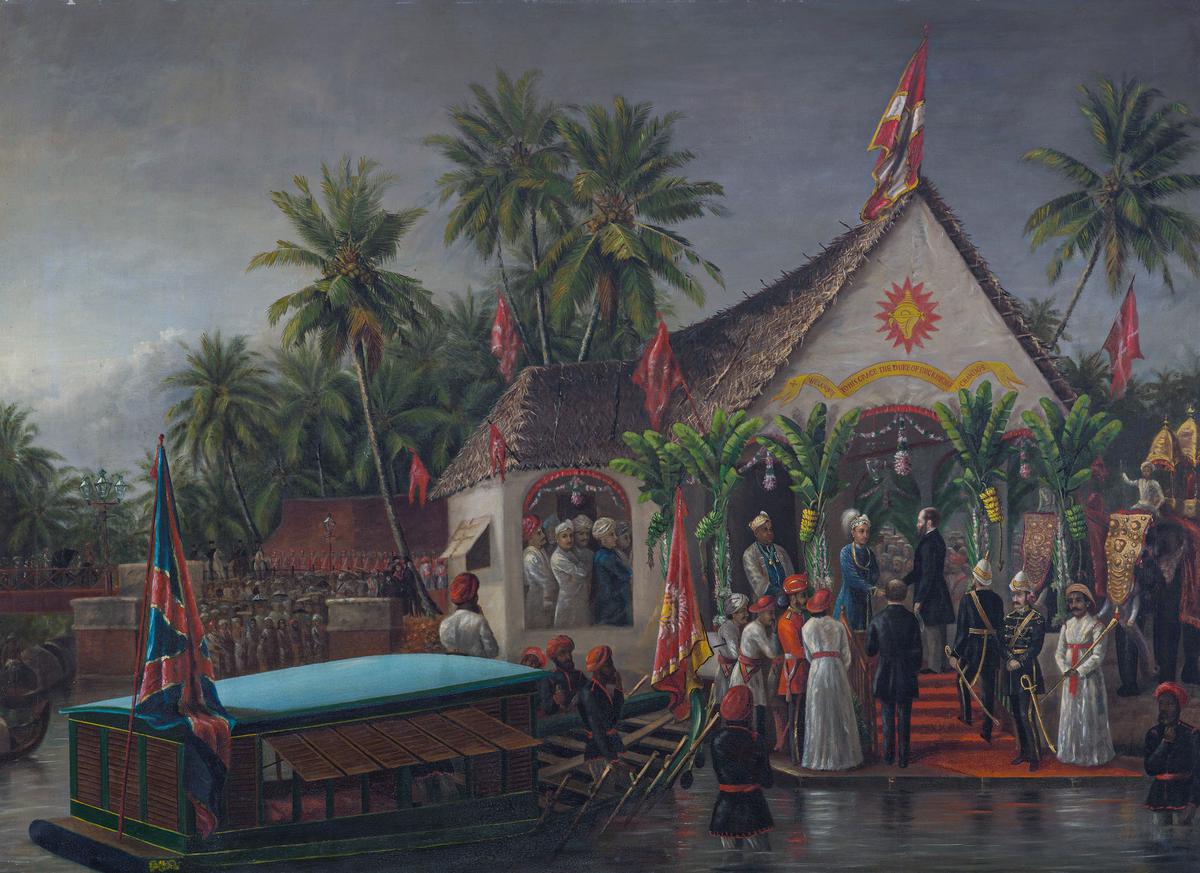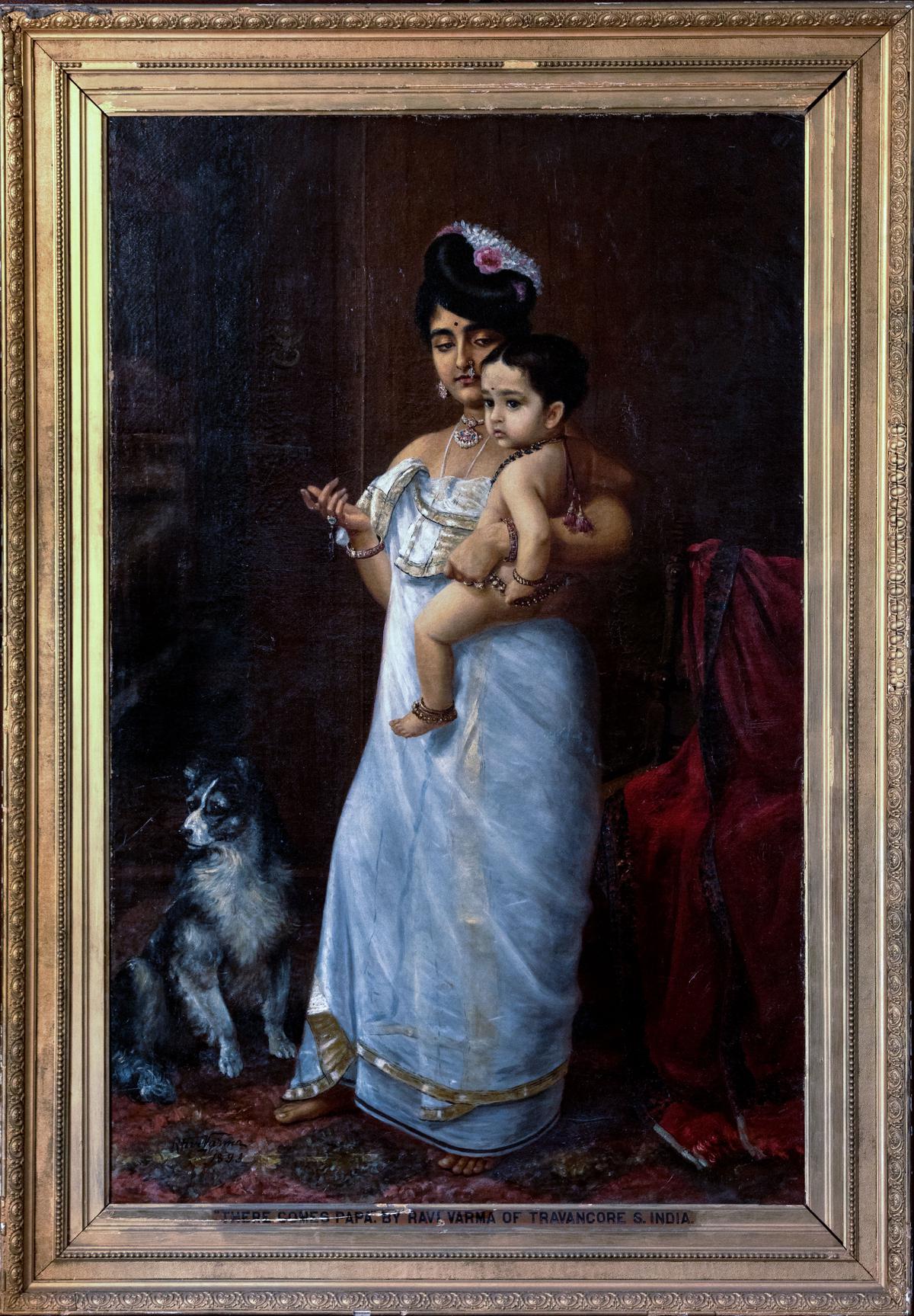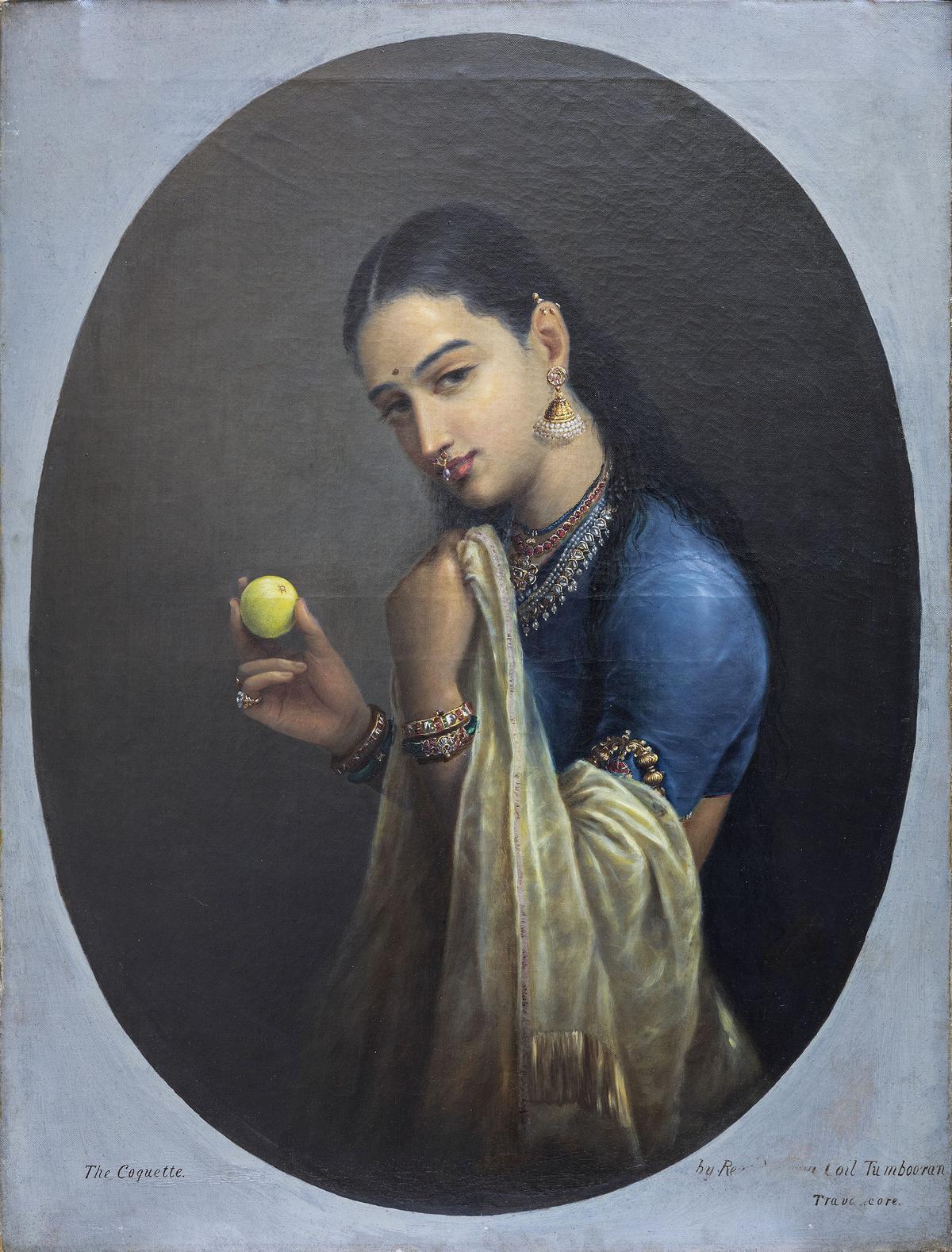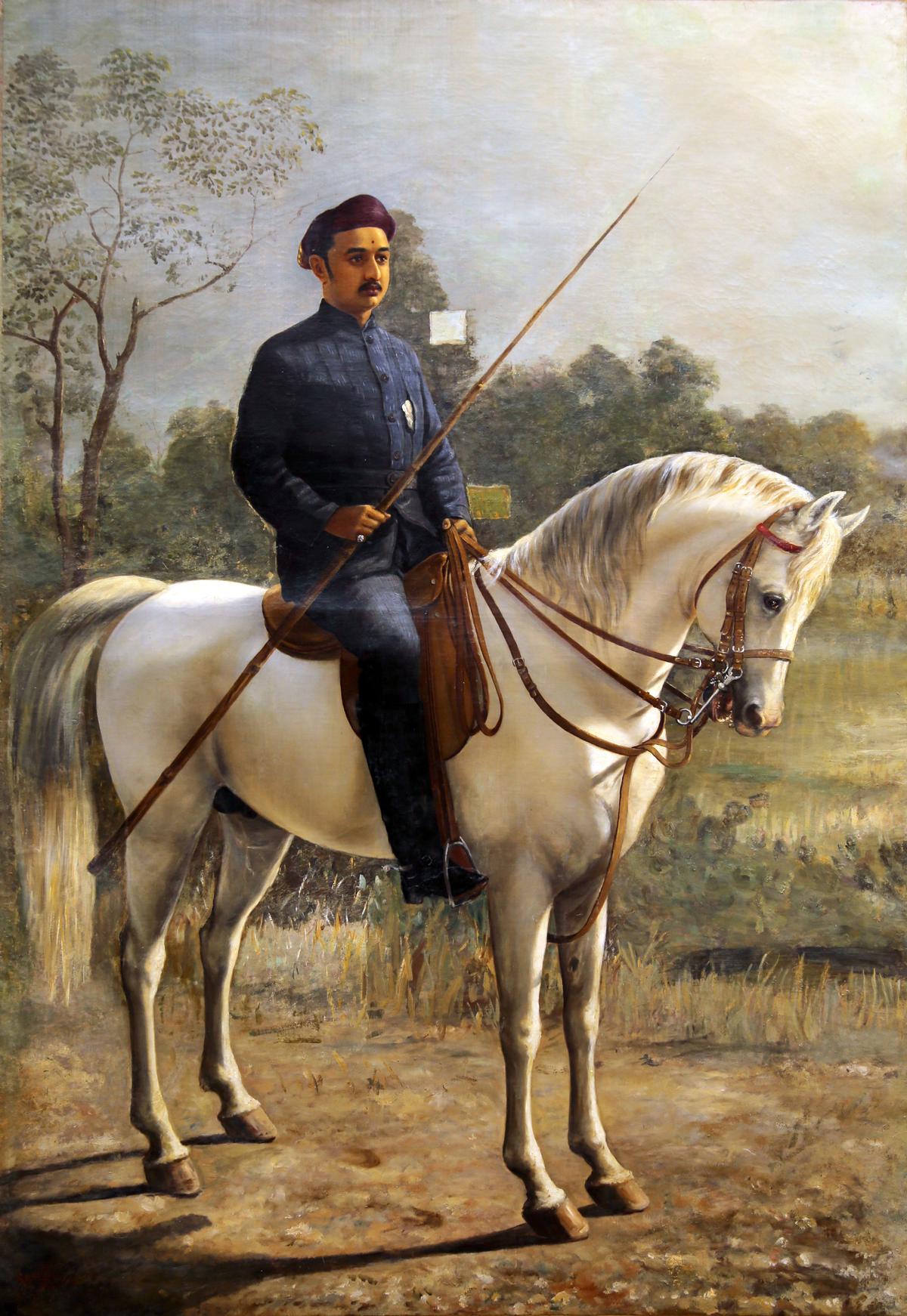shaping an artist is the first of a six volume series, a lasting impression, on the legacy of India’s foremost modern artist Raja Ravi Varma. Ganesh V Sivaswamy has appropriately released his book in the year of the artist’s 175th birth anniversary.
How did Ganesha, a lawyer by profession, become an authority on an iconic Indian painter, an aesthetic subject as far removed from legal jurisprudence as possible? After losing sight in one eye, the doctor who restored his sight advised a despondent young Ganesha to look into art. “I started collecting Ravi Varma chromolithographs when I was 16.”
The Brave Kusumavati, an 1896 painting by Raja Ravi Varma. , Photo Credit: Courtesy: Ganesh V. Sivaswamy
The result of six volumes is staggering: how does Ganesh separate himself from legal briefs and find time to research and document far-flung archival material? Rather he guiltily admits that Covid was a gift to him: “I could only concentrate on working on these books. I had only intended to write a book. First, I asked myself whether there was anything new to be said when so much has already been written about them. Then I quickly realized that alas, the biggest part of Ravi Varma’s legacy hasn’t been addressed: How does the image affect the common man? Only the patrons, the elite, were written about. The investigation of Ravi Varma Press was neglected. I was interested in how it became a force for change in the common man’s field. Can art exist in isolation, when the whole world is democratized in other ways? The chromolithograph was rejected as not being high art. As stated in my introduction, what is high art?”
The question is valid, because cultural boundaries have been breached. Art has gone from gallery wall to Banksy’s graffiti, from canvas to Hockney’s digital screen. Ravi Varma would have approved. Art cognoscenti looked for his originals in museums or private collections and sought copies of his works, but he considered making copies of paintings unoriginal, a waste of time. So he established the Ravi Varma Press in Bombay in 1894. Its prints would make “high art” accessible to the masses, carrying it from the court to the courtyard, from the patron to the prose. His success was phenomenal: Ravi Varma chromolithographic images were eagerly purchased, appearing on shop walls, calendars and inevitably in worship rooms. Grandmothers lovingly sewed silk and bright sarees onto the paintings – pink for Lakshmi and white for Saraswati – and affixed beads and shiny sequins to adorn them with jewellery. The demand for such images and the market led art intermediaries to dismiss Ravi Varma as mere buffoonery, and reproductions were junked in storerooms or antique shops. But taste has come full circle and the prints are now highly coveted, justifying Ganesh’s decision to reevaluate and reinstall them.

A portrait of the Maharaja of Travancore and his younger brother welcoming Richard Temple-Grenville, 3rd Duke of Buckingham and the Governor-General of Madras Chandos (1875-80) on their official visit to Trivandrum in 1880. Photo Credit: Photo Credit: Ganesh V. Sivaswamy
The book documents a time when an Indian artist was trying to validate himself, contrary to tradition in which the artist was anonymous. Ravi Varma too had to deal with the Raj’s contemptuous attitude towards all things Indian. Here a painter was encroaching on the monopoly of foreign artists. His royal status helped open doors, particularly to the courts of Baroda and Mysore, whose commissions are recorded and illustrated in the book, and further elaborated in section 4. His artist-uncle encouraged his talents, stimulating his aesthetic sensibilities with art magazines and prints. , while palace murals, temple sculpture and Kathakali provided the traditional images. His artist brother, C. Raja Raja Varma, had even more support. They jointly executed some works, with Ravi Varma focusing on people, while his brother was more biased towards landscapes. He traveled extensively, recording regional differences and ethnic types with detail, which enriched his work, and it was also a process of democratization he sought.

Raja Ravi Varma’s 1893 painting ‘There Comes Papa’. , Photo Credit: Photo Credit: Ganesh V. Sivaswamy
The book is a treasure trove of high quality reproductions, as well as valuable background linking the illustrations to the many sketches, models and photographs. Along with telling the details, Ganesha shows how the reference material culminates in the final act. When models were not available, the artist relied on photographs. The creative process that transformed the initial picture of Gauri into three pictures of Shodhana or Charm is explained. The coquette is a wonderful adaptation: this beauty invites with her direct gaze, a look full of hope. there’s a suggestive touch that’s how Pallava “Accidentally” Slipped Off Her Shoulder, An Unintentional Harbinger Of Bollywood dikhava, The painting resonates in style and content with hints of Western art: she holds an apple, suggesting an oriental Eve, an homage to Western iconography.
In a rare instance of an aristocratic lady sitting for a painting that was not commissioned, her daughter posed with her child which was changed to the painting ‘There Comes Papa’. It is also unusual to include a dog. His love for horses is recorded in the many sketches and watercolors that progressed into paintings. His dramatic inclination emerges in several narrative paintings.

Coquette, Raja Ravi Varma’s masterpiece | Photo Credit: Ganesh V. Sivaswamy
There are very useful close ups with splendid images, which Ganesha uses to explain the painting, ‘The Maharaja of Travancore Welcoming the Duke of Buckingham and the Chandos’. Raj protocol demanded that its representative be greeted with a Western-style handshake. But the caste – very strong in Malabar – decided that the king could not be touched. Ravi Varma’s solution was to partially obscure this offensive gesture by placing a man in the front. That some of his subjects were shocked or dismayed by the king’s concession to the British is shown by the attendants who hold their hands in front of their mouths, a gesture undoubtedly accompanied by a menacing “ay-yo”.

Sampatrao Gaekwad Ashwarohi’, a painting depicting Raja Ravi Varma’s love for horses. Photo Credit: Photo Credit: Ganesh V. Sivaswamy
The entire book abounds in fascinating details like this which showcase the phenomenal talent of Ravi Varma. The plentiful illustrations are an inspiration to the designers, as the book is also a wonderful record of dress, hairstyles, jewellery, regalia, interiors and architecture. Even after a comprehensive explanation of this first volume, Ganesha assures us that there is much more to come in the next five books!